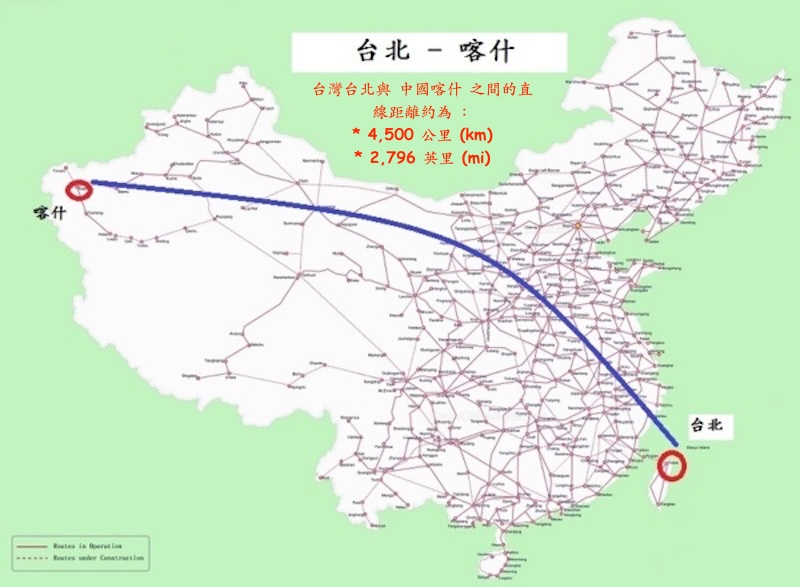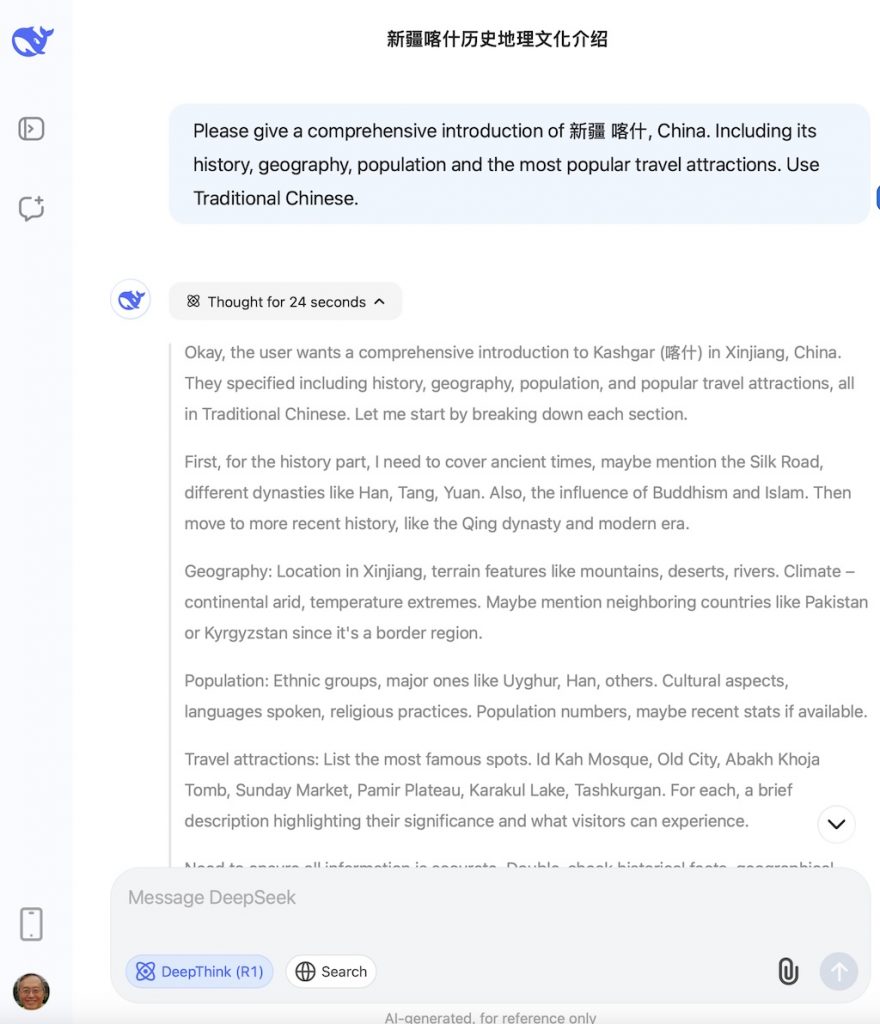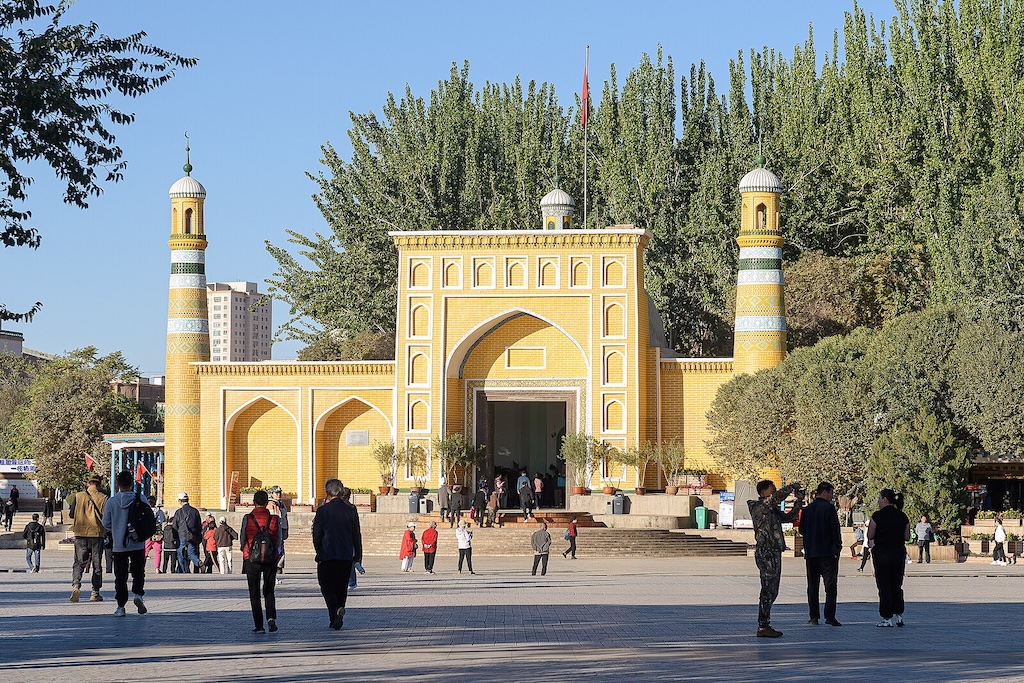
實拍新疆最神秘邊陲喀什古城,接壤三國的異域風情小城,新疆旅遊必去的喀什🇨🇳喀什古城丨南疆旅游丨高台民居丨維吾爾族丨中國旅遊丨旅遊攻略
Real shot of Xinjiang’s most mysterious border ancient city Kashgar, an exotic small city bordering the three countries, and a must-visit Kashgar in Xinjiang.
Prompt: Please give a comprehensive introduction of 新疆 喀什, China. Including its history, geography, population and the most popular travel attractions. Use Traditional Chinese.
to
#DeepSeek_AI

Okay, the user wants a comprehensive introduction to Kashgar (喀什) in Xinjiang, China. They specified including history, geography, population, and popular travel attractions, all in Traditional Chinese. Let me start by breaking down each section.
First, for the history part, I need to cover ancient times, maybe mention the Silk Road, different dynasties like Han, Tang, Yuan. Also, the influence of Buddhism and Islam. Then move to more recent history, like the Qing dynasty and modern era.
Geography: Location in Xinjiang, terrain features like mountains, deserts, rivers. Climate – continental arid, temperature extremes. Maybe mention neighboring countries like Pakistan or Kyrgyzstan since it’s a border region.
Population: Ethnic groups, major ones like Uyghur, Han, others. Cultural aspects, languages spoken, religious practices. Population numbers, maybe recent stats if available.
Travel attractions: List the most famous spots. Id Kah Mosque, Old City, Abakh Khoja Tomb, Sunday Market, Pamir Plateau, Karakul Lake, Tashkurgan. For each, a brief description highlighting their significance and what visitors can experience.
Need to ensure all information is accurate. Double-check historical facts, geographical data, and current population stats. Also, use Traditional Chinese terms correctly, like proper nouns and specific terms related to geography or historical events.
Wait, the user might be interested in cultural aspects, so maybe emphasize the blend of cultures in Kashgar. Highlight its role as a crossroads. Also, check if any attractions have UNESCO status or other recognitions.
Avoid any sensitive political issues, focus on tourism and cultural heritage. Make sure the introduction flows smoothly, each section transitions well. Use formal but engaging language suitable for a comprehensive overview.
Make sure to mention the Silk Road’s influence on Kashgar’s development as a trade center. Mention specific historical events, like Zhang Qian’s mission during the Han dynasty, establishment of the Protectorate, etc.
For geography, include the Tian Shan, Pamir Plateau, Taklamakan Desert. Rivers like the Tuman River. Climate details like hot summers, cold winters, low rainfall.
Population: Recent estimates, maybe around 4.5 million? Confirm the latest data. Ethnic composition percentages if available. Languages, religions, cultural practices like Uyghur traditions, music, festivals.
Travel attractions: Each should have a short paragraph. Id Kah Mosque’s history and architecture, Old City’s renovation, Sunday Market’s size and what’s sold there. Pamir Plateau’s natural beauty, Karakul Lake’s scenery, Tashkurgan’s stone city and ethnic culture.
Check for any recent changes, like the Old City’s renovation project completed in 2015. Also, transportation tips? Maybe not necessary unless specified, but the user didn’t ask for that. Stick to attractions.
Potential pitfalls: Ensuring up-to-date information, avoiding outdated stats. Also, cultural sensitivity when describing ethnic groups and religious sites.
Structure the answer with clear headings for each section: History, Geography, Population, Travel Attractions. Use bullet points or numbered lists for attractions? The user didn’t specify, but since it’s a comprehensive introduction, paragraphs under each section would be better.
Now, translate all this into Traditional Chinese, making sure terms are correctly used. For example, “Xinjiang” is 新疆, “Kashgar” is 喀什, “Silk Road” is 絲綢之路. Check for any terminology differences between Simplified and Traditional Chinese, especially proper nouns.
Finally, conclude with a summary highlighting Kashgar’s uniqueness as a cultural and historical destination. Ensure the tone is informative and engaging, suitable for readers planning to visit or research the area.
新疆喀什綜合介紹
歷史沿革
喀什(喀什噶爾的簡稱)位於中國新疆西南部,是絲綢之路上的重要樞紐,擁有超過兩千年的文明史。
古代:西漢時期(公元前2世紀),張騫通西域後,喀什成為漢朝與中亞交流的門戶。東漢時期,佛教經此傳入中原,當地曾建有多座佛寺。唐朝設立「安西四鎮」,喀什(時稱「疏勒」)為軍事與貿易重鎮。
伊斯蘭化:10世紀後,喀喇汗王朝推動伊斯蘭教傳播,喀什逐漸成為宗教與文化中心。元朝時,馬可·波羅曾記載其繁榮景象。
近現代:清朝平定準噶爾後,喀什設為南疆行政中心。20世紀以來,其戰略地位因毗鄰中亞各國而日益突出,現為「一帶一路」關鍵節點。
地理環境
喀什地處帕米爾高原東麓、塔里木盆地西緣,地理特徵多元:
地形:三面環山(天山、崑崙山、帕米爾高原),東臨塔克拉瑪干沙漠。地勢由西南向東北傾斜,河流包括克孜勒蘇河與吐曼河。
氣候:溫帶大陸性乾旱氣候,日照充足,年降雨量僅約100毫米。夏季炎熱(可達40°C),冬季寒冷(最低-20°C)。
- 全市年平均氣溫11.8 ℃,降水量60毫米,屬典型的溫帶沙漠氣候。
邊境:與巴基斯坦、阿富汗、塔吉克斯坦、吉爾吉斯斯坦接壤,是中國向西開放的前沿。
喀什以南為崑崙山脈,以北為天山南脈。喀什噶爾河穿流而過。境內地勢平坦,土地肥沃,綠洲農業發達,物產豐富。盛產各種瓜果,有紅桃、葡萄、黃杏、蘋果、梨、甜瓜、西瓜、石榴、櫻桃、酸梅、巴旦木、阿月渾子等諸多品種,並衍生出了規模較大的食品和特色農副產品加工業。
人口與文化
人口:截至2023年,喀什地區常住人口約450萬,以維吾爾族為主(佔80%以上),漢族及其他少數民族(塔吉克、柯爾克孜等)共同構成多元社會。
語言與宗教:通用維吾爾語(屬突厥語系)和漢語,多數居民信仰伊斯蘭教。傳統節日如古爾邦節、肉孜節極具特色,木卡姆音樂、刀郎舞蹈被列入非物質文化遺產。
主要旅遊景點
艾提尕爾清真寺
中國最大的伊斯蘭教寺院,始建於1442年明代,融合中亞與波斯建築風格,可容納萬人禮拜。每逢節日,廣場上舉行盛大薩瑪舞表演。喀什老城
保存完好的生土建築群,街巷蜿蜒如迷宮,2015年修繕後入選「國家5A級景區」。遊客可體驗維吾爾族家庭作坊,品嘗烤包子、手工冰淇淋等美食。香妃墓(阿帕克霍加墓)
17世紀伊斯蘭聖裔陵園,傳為乾隆帝香妃的衣冠塚。藍色穹頂與琉璃磚裝飾華麗,內部陳列家族棺木與文物。喀什大巴扎(中亞國際市場)
絲路貿易的活化石,尤以週日市集聞名。販售乾果、地毯、銅器、藥材等,充滿異域風情。帕米爾高原
被譽為「世界屋脊」,沿途可覽慕士塔格峰(海拔7509米)、公格爾九別峰。自駕「中巴友誼公路」(喀喇崑崙公路),感受冰川與草原交錯的壯麗。卡拉庫里湖
高原湖泊,湖水隨光影變幻為青藍或墨綠,倒映慕士塔格峰的雪頂,是徒步與攝影勝地。塔什庫爾干石頭城
唐代遺址,曾為西域三十六國之一的「羯盤陀國」都城,現存殘垣斷壁述說絲路滄桑。周邊塔吉克族村落保留鷹舞與叼羊習俗。
總結
喀什是「絲路活體博物館」,融合中原與中亞文明,宗教、藝術、商貿在此交織。無論是探尋古城脈絡,還是領略高原秘境,皆能感受其跨越千年的生命力與獨特魅力。

艾提尕爾清真寺詳述
歷史淵源
艾提尕爾清真寺(Id Kah Mosque)是中國規模最大、最具影響力的伊斯蘭教寺院,位於喀什市中心,始建於1442年(明正統七年)。其歷史可追溯至更早的喀喇汗王朝時期,最初為一小片墓地。15世紀中葉,喀什統治者沙克色孜·米爾扎為紀念亡叔在此修建清真寺,後經多次擴建:
16世紀:葉爾羌汗國君主擴建寺院,增建穹頂、禮拜殿與庭院,奠定今日主體格局。
18世紀:清乾隆年間,維吾爾族女富商古麗熱娜出資修建寺門與宣禮塔,形成現今標誌性外觀。
20世紀至今:歷經多次修繕,1980年代被列為全國重點文物保護單位,並成為中國伊斯蘭教協會重要活動場所。
建築特色
寺院占地約1.68萬平方米,融合波斯、中亞與中原建築藝術,體現伊斯蘭美學與地域文化的交融:
寺門與宣禮塔
高12米的鵝黃色拱形寺門,兩側聳立18米高的米黃色宣禮塔,塔身飾以几何紋與葡萄藤浮雕,頂端新月標誌象徵伊斯蘭信仰。
宣禮塔原為召喚信徒禮拜之用,現因擴音設備普及,主要保留裝飾功能。
禮拜殿
主殿長140米、進深16米,由158根藍綠色雕花木柱支撐,柱頭裝飾蓮花、卷草紋樣,地面鋪設傳統艾德萊斯花紋地毯。
殿頂為白色穹窿結構,外側環繞綠色琉璃磚,內壁書寫《古蘭經》經文,以阿拉伯書法與彩繪花卉點綴。
庭院與附屬建築
中央庭院可容納萬人集體禮拜,四周環繞拱廊與講經堂。
東側設有伊斯蘭經學院(麥德里斯),曾為新疆宗教教育中心,培養大量宗教學者。
宗教與文化意義
信仰核心:作為喀什乃至新疆穆斯林的宗教聖地,每日五次禮拜(邦克)從不間斷,主麻日(週五聚禮)常聚集數千信徒。
節慶中心:
古爾邦節與肉孜節期間,寺院廣場舉行盛大慶典,信徒跳起「薩瑪舞」(Sama),以旋轉、吟誦表達對真主的虔誠。
每年齋月(Ramadan),寺院提供免費齋飯(Iftar),體現社區互助精神。
文化象徵:
寺院建築群見證了喀什從佛教中心轉向伊斯蘭文化重鎮的歷史進程。
其建築風格影響了新疆其他清真寺的設計,如吐魯番蘇公塔清真寺。
旅遊參觀指南
開放時間:
每日10:00-20:00(非禮拜時段開放參觀),禮拜期間(約每日5:30、13:30、16:00、18:30、21:30)遊客需避免進入主殿。
門票:約20元人民幣,含簡介手冊。
注意事項:
衣著需端莊,女性建議包頭巾,男性勿穿短褲。
主殿內禁止拍照,庭院與外圍建築可攝影。
尊重禮拜儀式,保持安靜,避免打擾信徒。
周邊體驗:
寺前廣場為喀什老城地標,周邊遍布手工藝品店與茶館,可品嘗維吾爾藥茶(Chai)與烤鵝蛋。
夜間寺門與宣禮塔打上燈光,呈現金色輝煌的夜景。
結語
艾提尕爾清真寺不僅是宗教場所,更是喀什千年文明的縮影。其建築藝術、信仰實踐與節慶傳統,生動詮釋了絲綢之路上多元文化的共生共榮。無論是仰望宣禮塔的莊嚴輪廓,還是感受庭院中虔誠的誦經聲,皆能觸摸到這座古城的精神脈動。

